SEO audit tools are vital to any search engine marketing tool stack.
The best tools can help you easily identify the issues hurting your site’s performance in search results.
Whether you’re a site owner, SEO professional, or content manager, you can leverage these tools to prioritize the most urgent fixes for your site. You’ll also help boost rankings, generate more traffic, and capture more conversions.
Let’s jump right into the best tools for the job.
Every website needs a regular checkup. Think of it like preventative care—audits let you take care of minor issues before they can become major problems.
Plus, audit tools will recommend easy ways to maintain or improve your current rankings, helping your site get more exposure and traffic year-round.
Here are our topic picks for the best SEO audit tools.
The Semrush Site Audit tool makes it easy to run an SEO audit and fix over 140 potential issues.
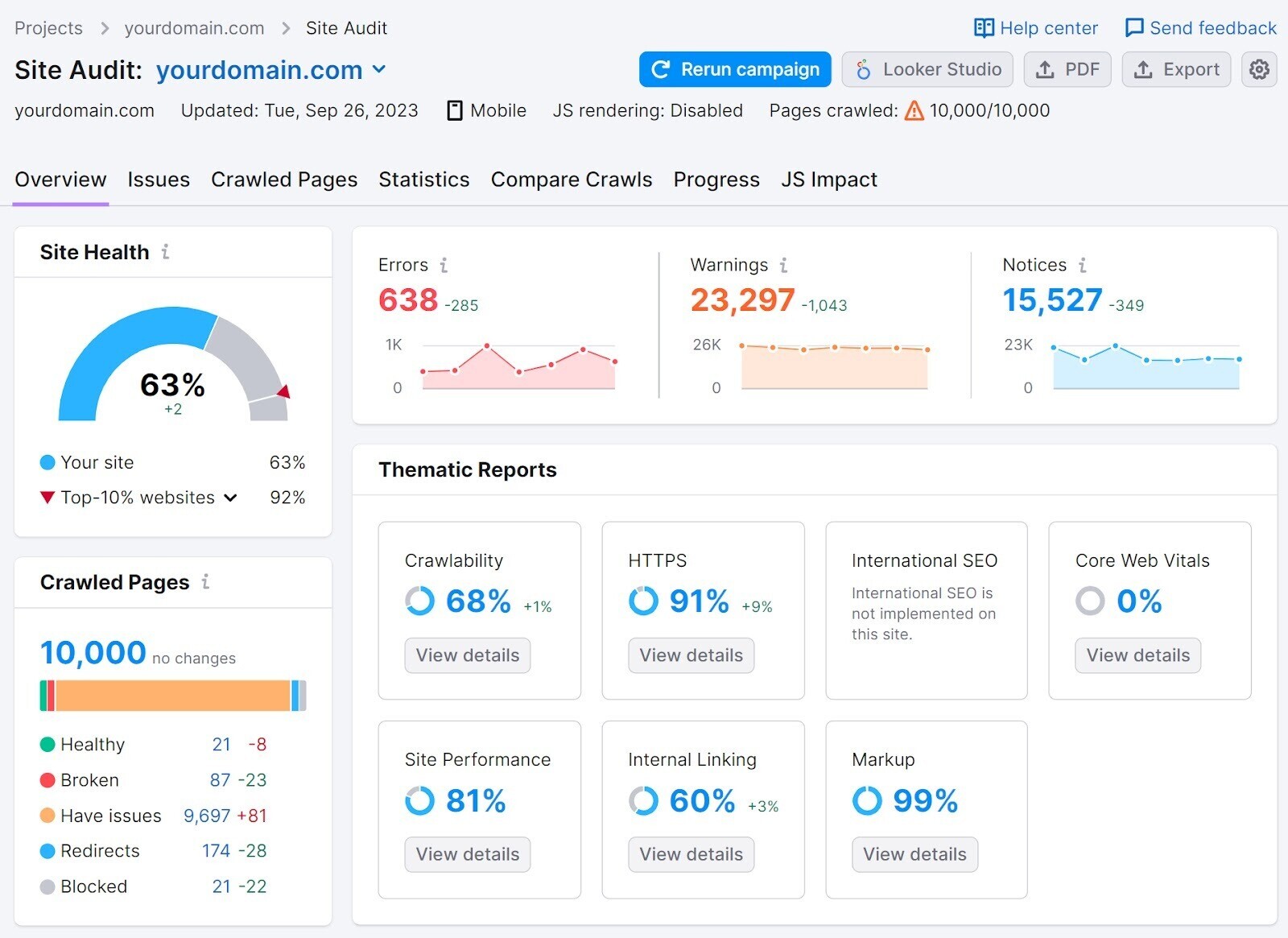
The Site Audit report breaks down the full SEO audit into seven thematic reports:
- Crawlability: Page indexability, crawl budget optimization, crawl depth, and more
- HTTPS: Secure vs. non-secure pages and security certificates
- International SEO: Hreflang implementation
- Core Web Vitals (CWV): Largest Contentful Paint, Total Blocking Time, and Cumulative Layout Shift
- Site performance: Page load speed, load time, file size, redirects, JavaScript, and CSS reports
- Internal linking: Internal link distribution, broken internal links and external links, and anchor text optimization
- Markup: Structured data, Schema.org markup, Open Graph data, Twitter cards, and microformats
To run a website audit using Site Audit, follow these steps:
From Semrush, click “Site Audit” under “On Page & Tech SEO.”
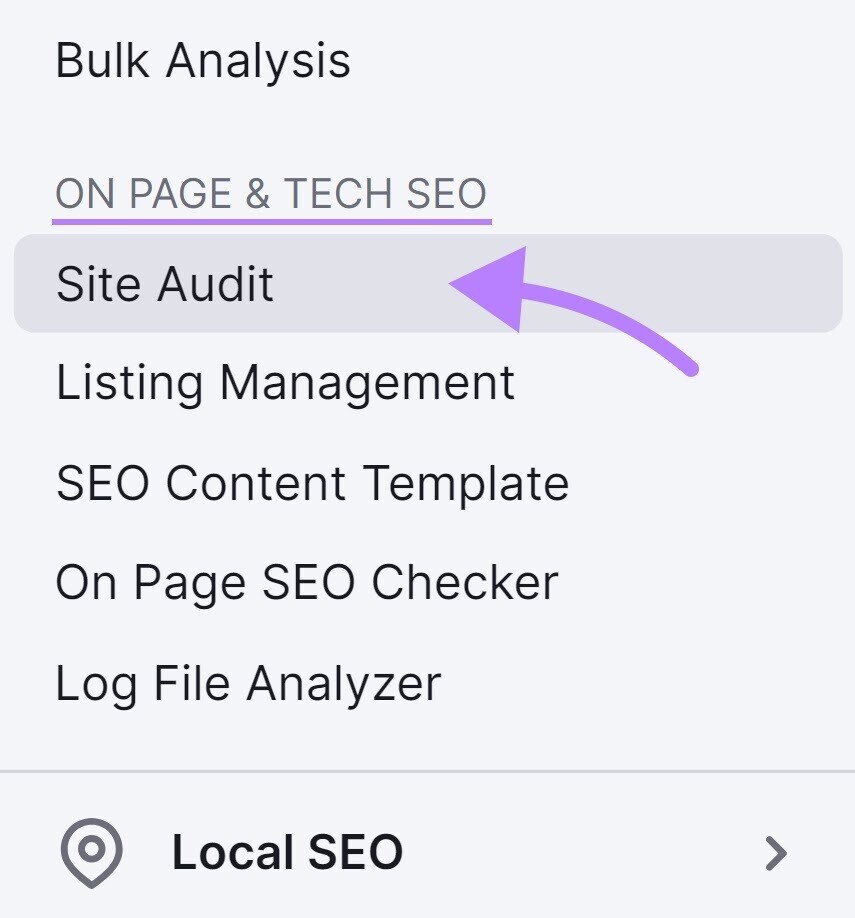
Type in the URL of the website you want to audit. Click “Start Audit.”
Note: If you already have a project set up in Semrush, you’ll need to click “+ Create project” to add a new project and run a new audit.

Then, from the “Site Audit Settings” box, choose the number of pages you want to check in your audit and click “Start Site Audit.”
You can crawl up to 100 pages with a free account. With a Pro account, you can crawl up to 20,000 per audit and up to 100,000 per month.
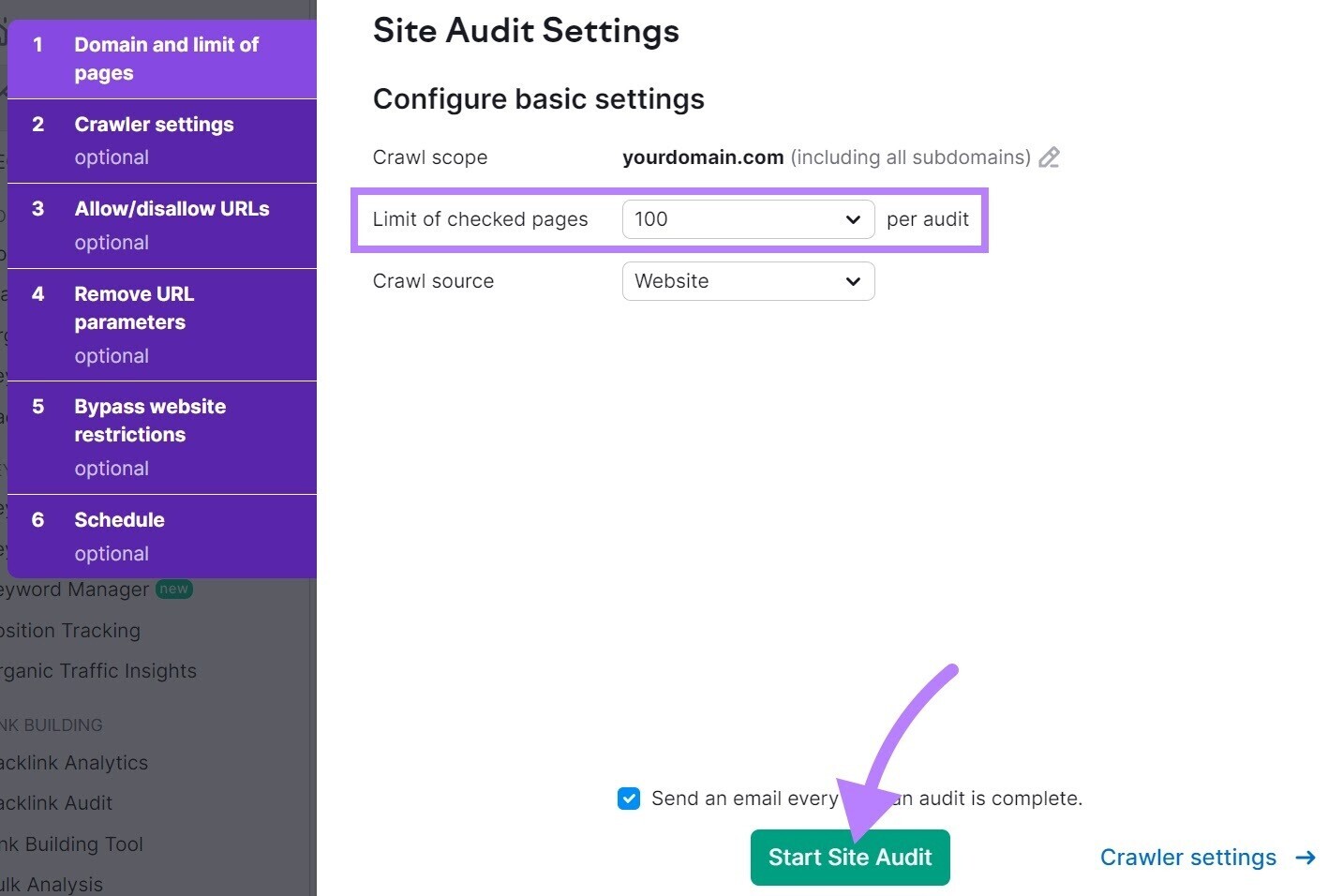
Pro tip: Once you’re comfortable running Site Audit, you can customize crawl and output in settings.
Let the report run. It will take some time for the Site Audit crawl bot to check your pages, content, images, and links.
When it’s finished, you’ll receive a report like the one below. You’ll also see a list of the top issues.
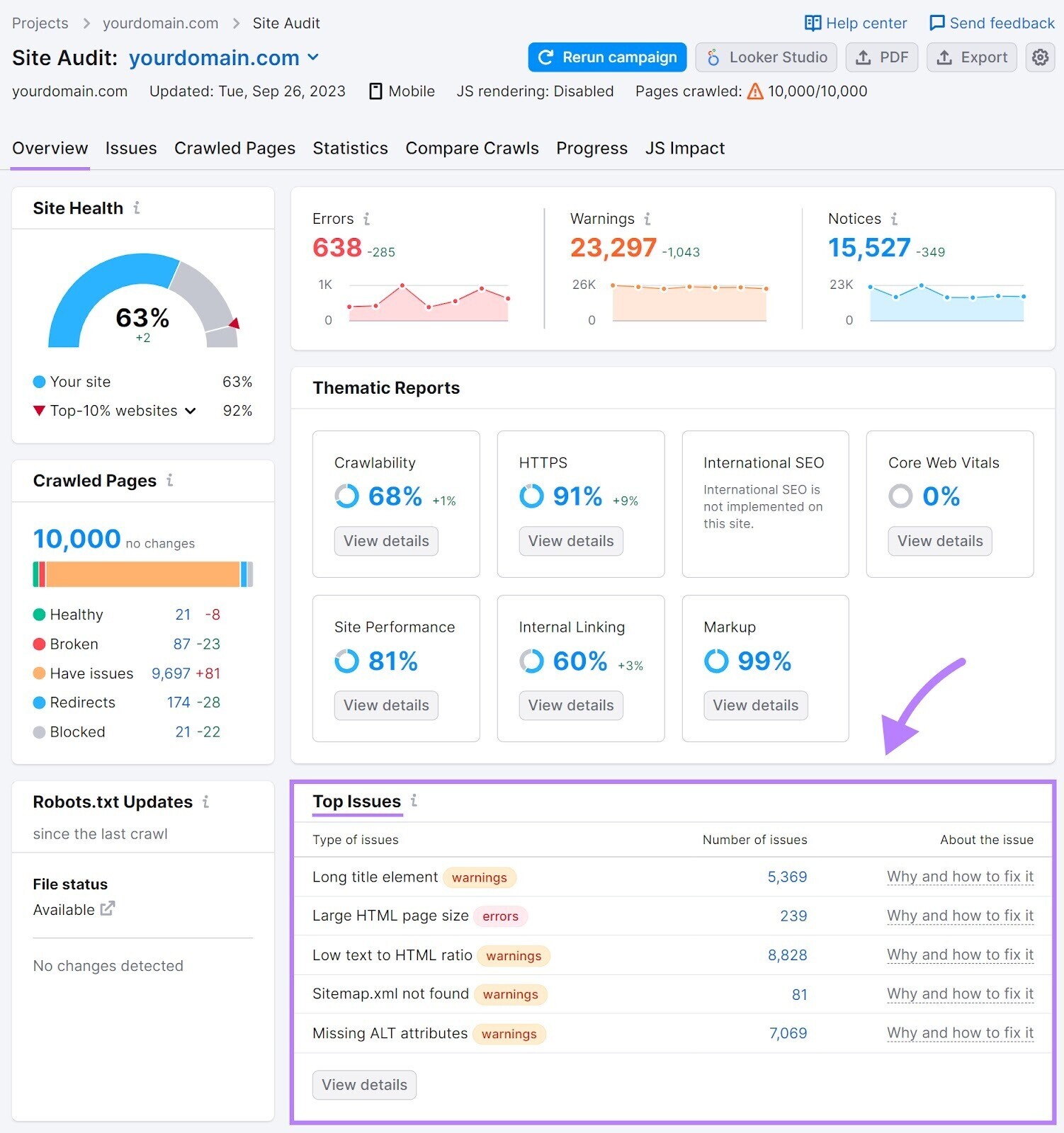
Click “Number of issues” for any of these items to see a detailed list of the uncovered SEO errors or issues.
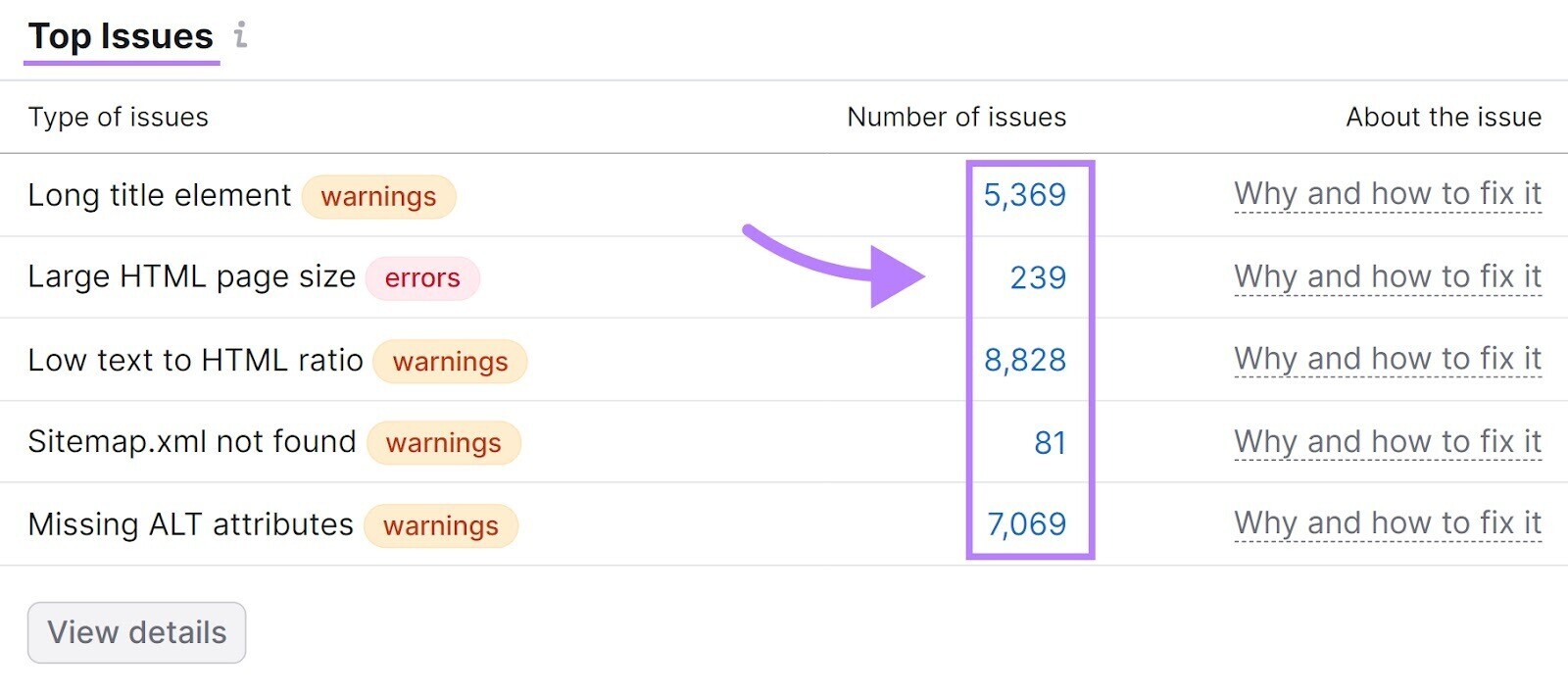
If you’re unsure of where to start, look at the prioritization widgets at the top of the report.

This section breaks issues down into three categories:
- Errors: Highest-severity issues you should address immediately
- Warnings: Medium-severity issues you should address as soon as you can
- Notices: Not considered issues and may not require any action—this is more for user awareness.
This will help you easily prioritize the most critical issues before they become major headaches.
2. Semrush On Page SEO Checker
Use the Semrush On Page SEO Checker tool to generate a comprehensive list of improvements to your site’s on-page SEO.
This tool analyzes pages, content, and competitors and provides data-driven recommendations like:
- Ideas for improving your content
- Opportunities to earn backlinks
- Featured snippet and SERP feature opportunities
- Semantically related keywords you can add to existing content
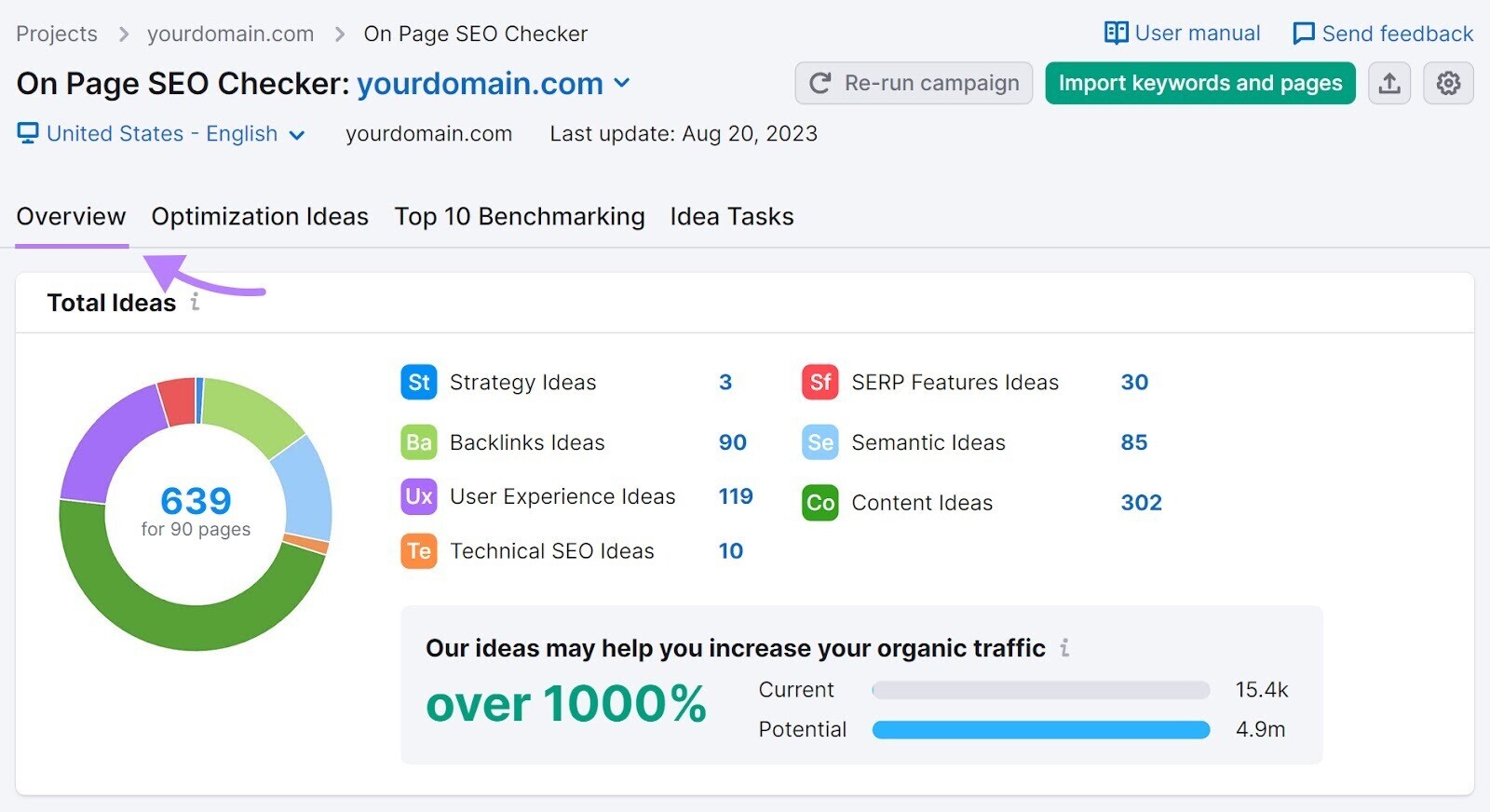
This tool allows you to import specific URLs or keywords on your website and receive customized, data-driven recommendations for improving your site’s SEO and performance.
It breaks down the recommendations into seven groups:
- Strategy ideas: Pages that already rank for your desired keywords and how to better optimize them to get even more traffic, and keyword cannibalization issues (when two or more pages are competing for the same keywords)
- Backlink ideas: Website recommendations that may be a good fit for link partnerships or collaborations to help improve your site’s rankings
- User experience ideas: Recommendations for areas of your website that could benefit from an improved user experience
- Technical SEO ideas: Issues related to metadata, title tags, crawlability, and other common problems
- SERP features ideas: Opportunities to target SERP features like featured snippets and reviews, which can help you capture additional real estate in the search results
- Semantic ideas: Additional topic and keyword suggestions that could enhance the quality and depth of your content
- Content ideas: Suggestions for optimizing your content to better rank in search engine results
Here’s how to use On Page SEO Checker:
Inside Semrush, click “On Page SEO Checker” under “On Page & Tech SEO.”
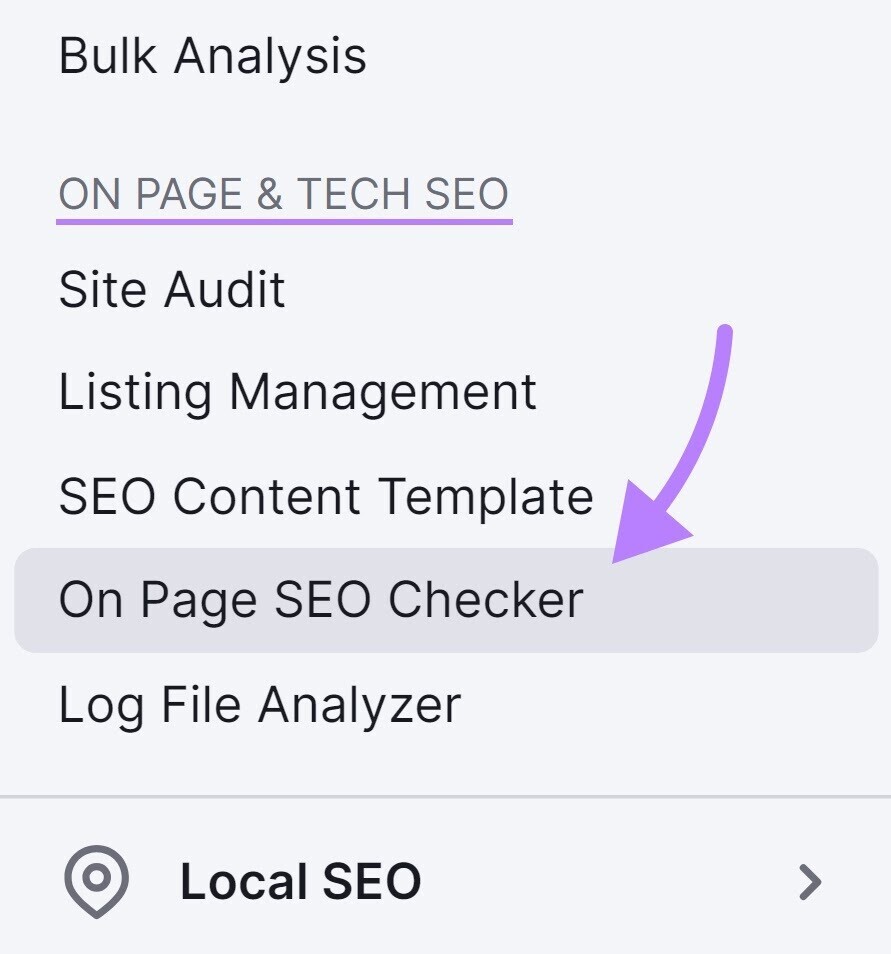
Now, enter the website you want to analyze and click “Get ideas.”
Note: If you already have a project set up in Semrush, you’ll need to click “+ Create project” to add a new project and run a new report.

Next, you’ll see the “Select target location” dialog box.
Here, you can modify variables that impact how Semrush views your site for the analysis. Click the drop-down to choose a location, language, and device that matches how you want to audit your site. Then click “Continue.”
Pro tip: Need help determining which settings to select? Leave the drop-down as the default setting and click “Continue.”
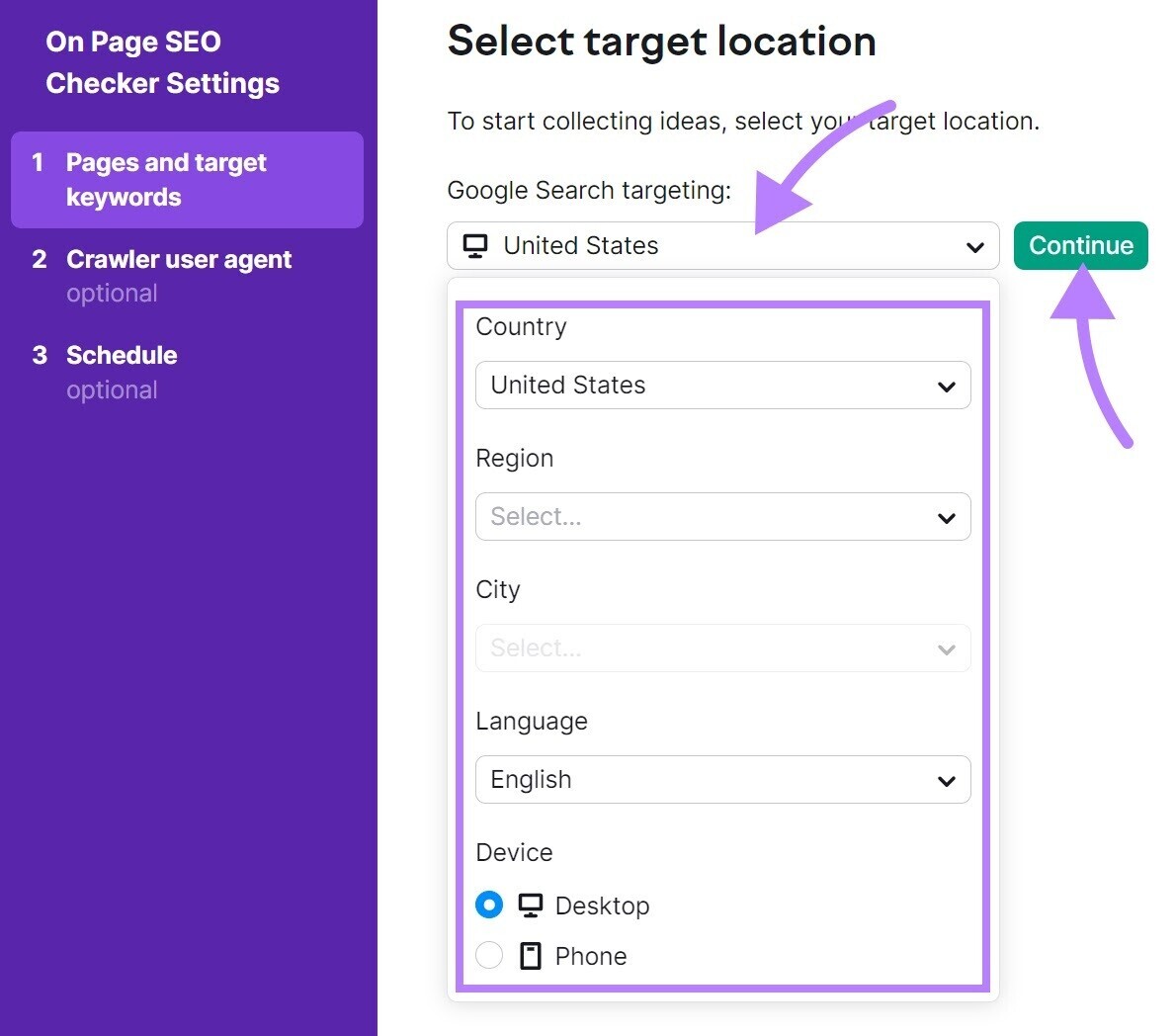
You’ll see the “Add pages to optimize” screen. This is where you’ll select the pages you want to audit and provide target keywords.
Start by reviewing the options under “Auto import.” You can remove any automatically suggested options by clicking the remove button that looks like a trash can.
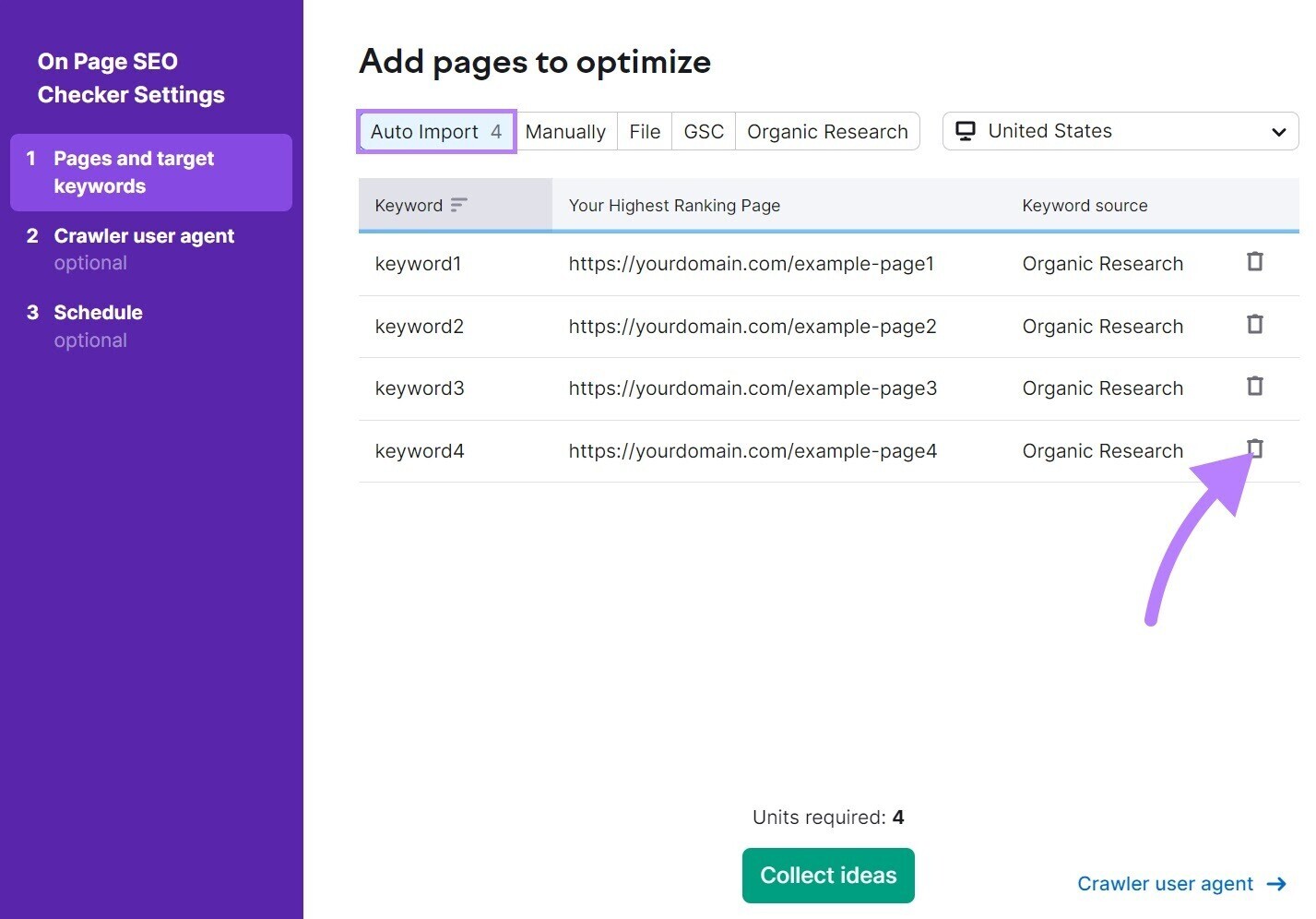
Add your pages to the analysis by clicking the “Manually” tab at the top of the screen. Then, type or paste the URL of the page you want to analyze and your target keyword. Click “Add Page.”
Pro tip: You can upload a file to add a list of URLs, pull URLs from Google Search Console, or use the Organic Research option to help you find pages to analyze using the other tabs at the top.

Once you’ve selected the relevant pages you want to analyze, click “Collect ideas.”
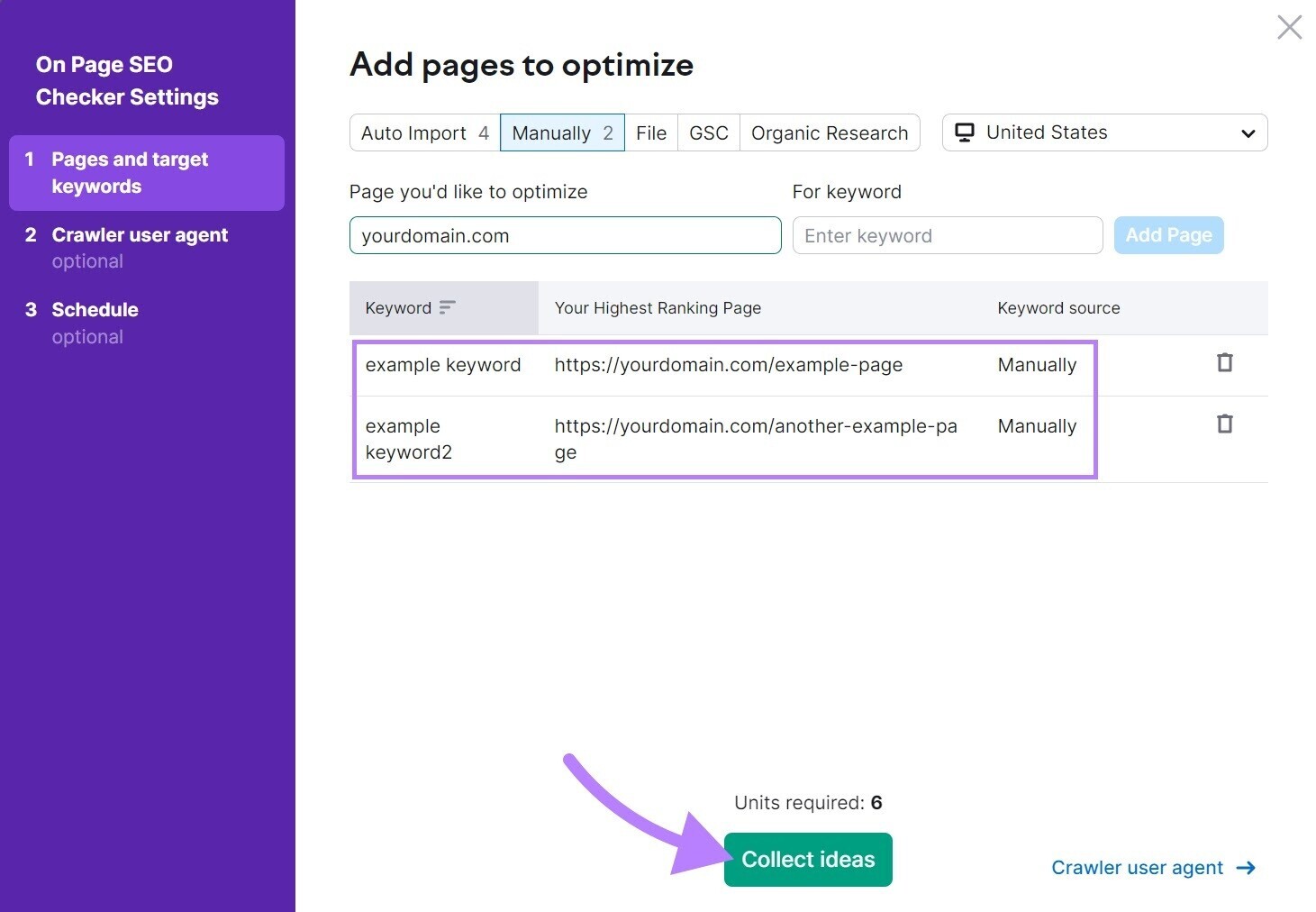
Now, the On Page SEO Checker will analyze your selected pages. Once the audit is complete, you’ll see the On Page SEO Checker report page.
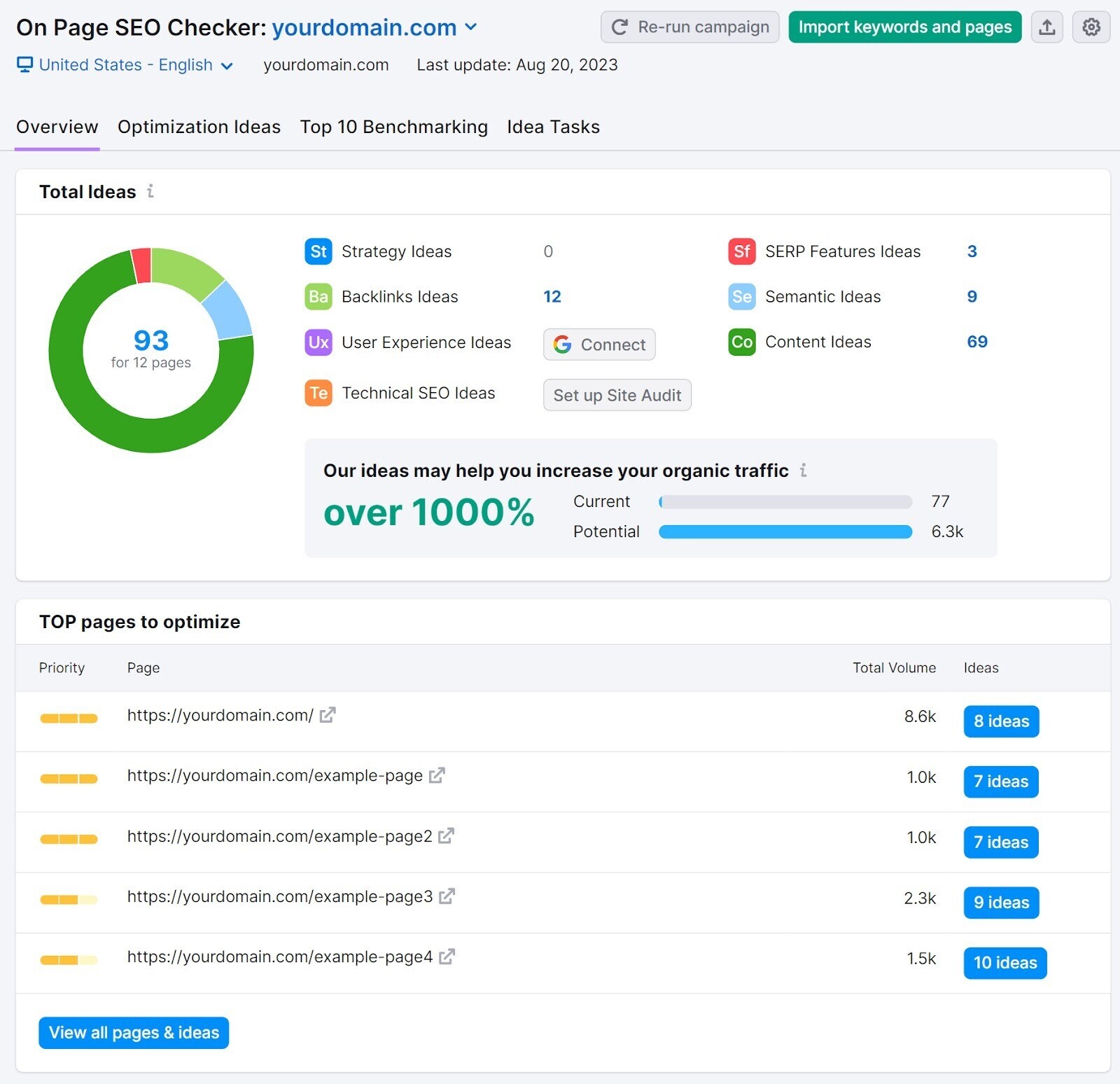
To dig into the suggestions provided, click the number next to one of the categories listed under “Total Ideas.” Or click the number of ideas shown for a specific page under the “TOP pages to optimize” section.
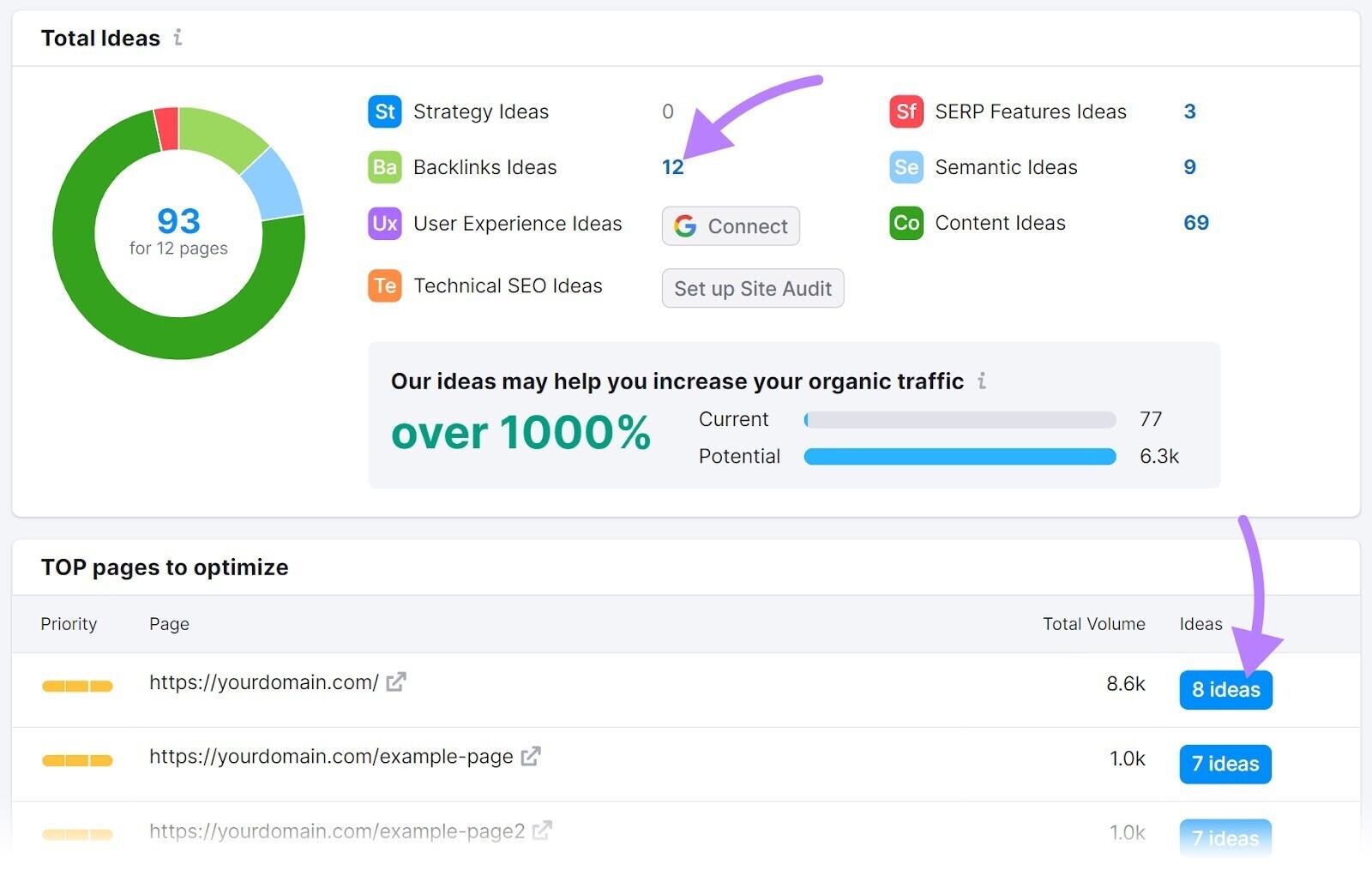
Once you’ve clicked into the report, you’ll see a detailed list of specific ideas for each page, broken down into seven categories. Each one contains an action item and information on how to address an issue or implement an idea.
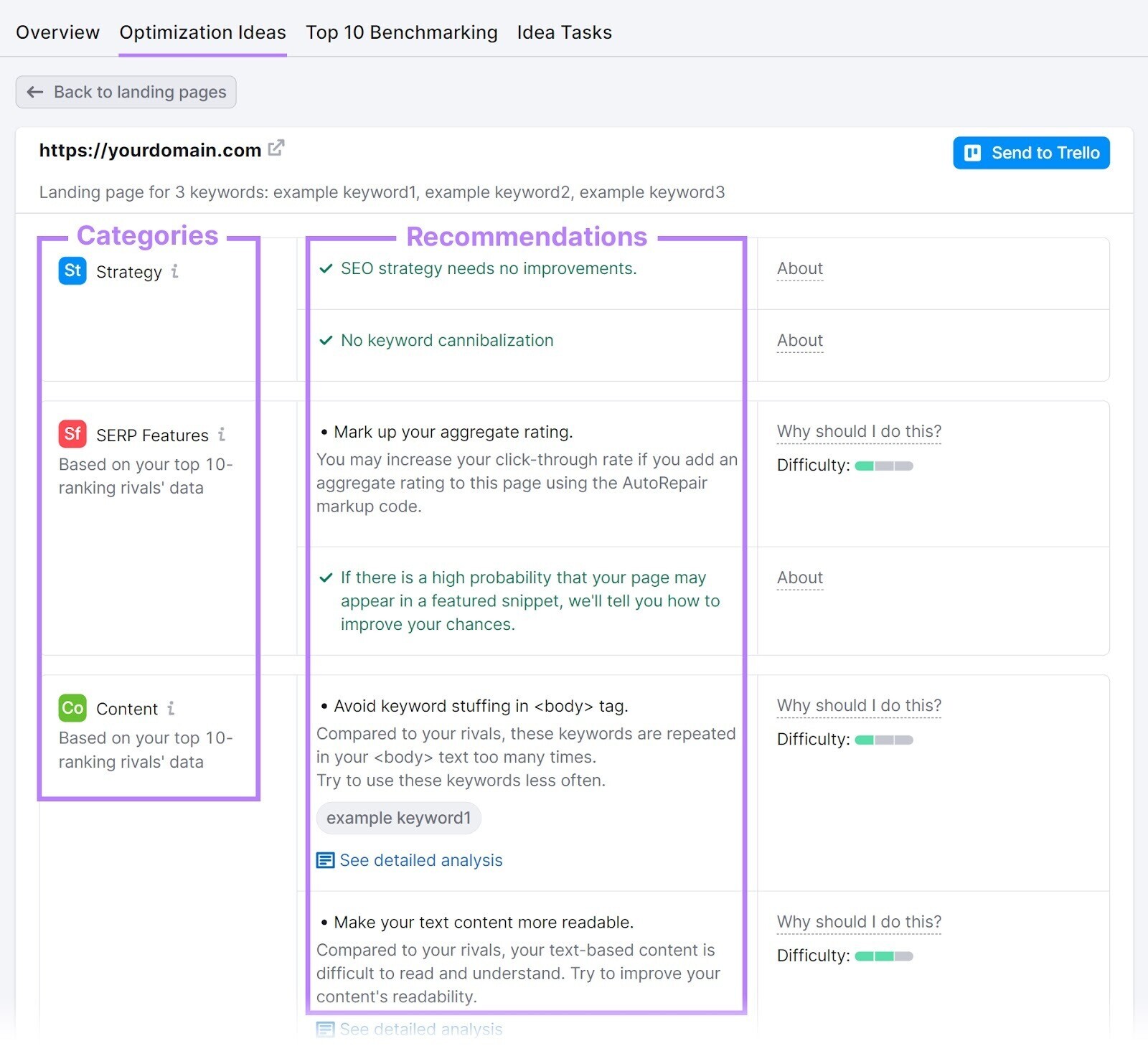
3. Google Search Console
If you’re looking for free SEO audit tools, Google Search Console (GSC) is a great option. It provides you with data from Google about your site’s crawlability, indexability, and search performance.
This information will help you address any issues and optimize your site.
However, GSC is not as comprehensive as other tools and won’t provide you with a list of action items or ideas like Site Audit and On Page SEO Checker.
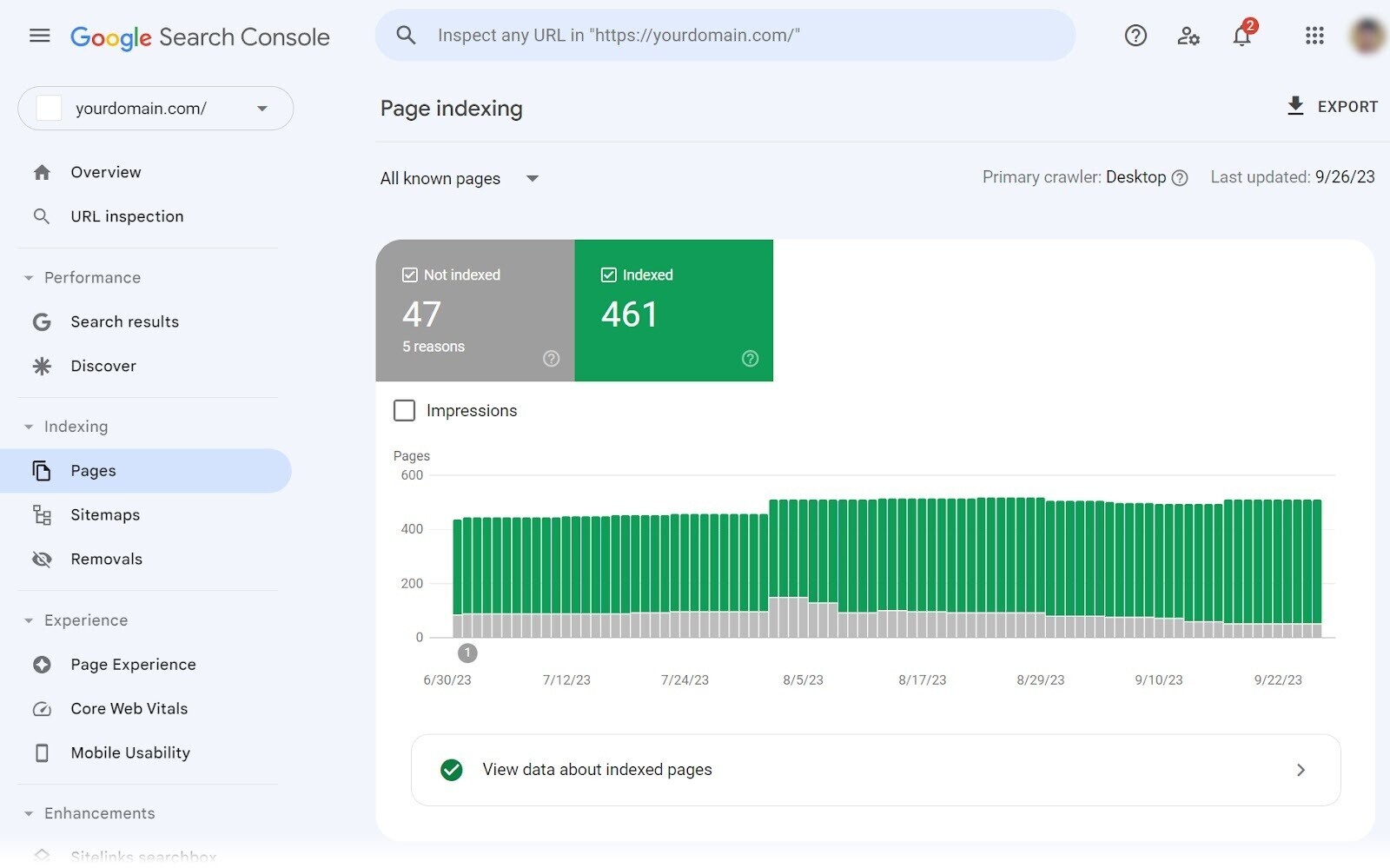
Using the provided reports, you can see how your website is crawled and indexed by Google, the XML sitemaps it’s discovered, keyword rankings data, website speed and performance, and even backlink information.
GSC data integrates directly with Google Analytics. The API also allows you to pull the data into many third-party tools, including the Semrush On Page SEO Checker.
4. Google PageSpeed Insights
Your site’s load speed, performance, and usability affect your rankings. Learn what search engines and users experience on your site with the free SEO audit tool PageSpeed Insights.
You can use the analysis and detailed suggestions to resolve website performance problems and improve user experience and rankings.
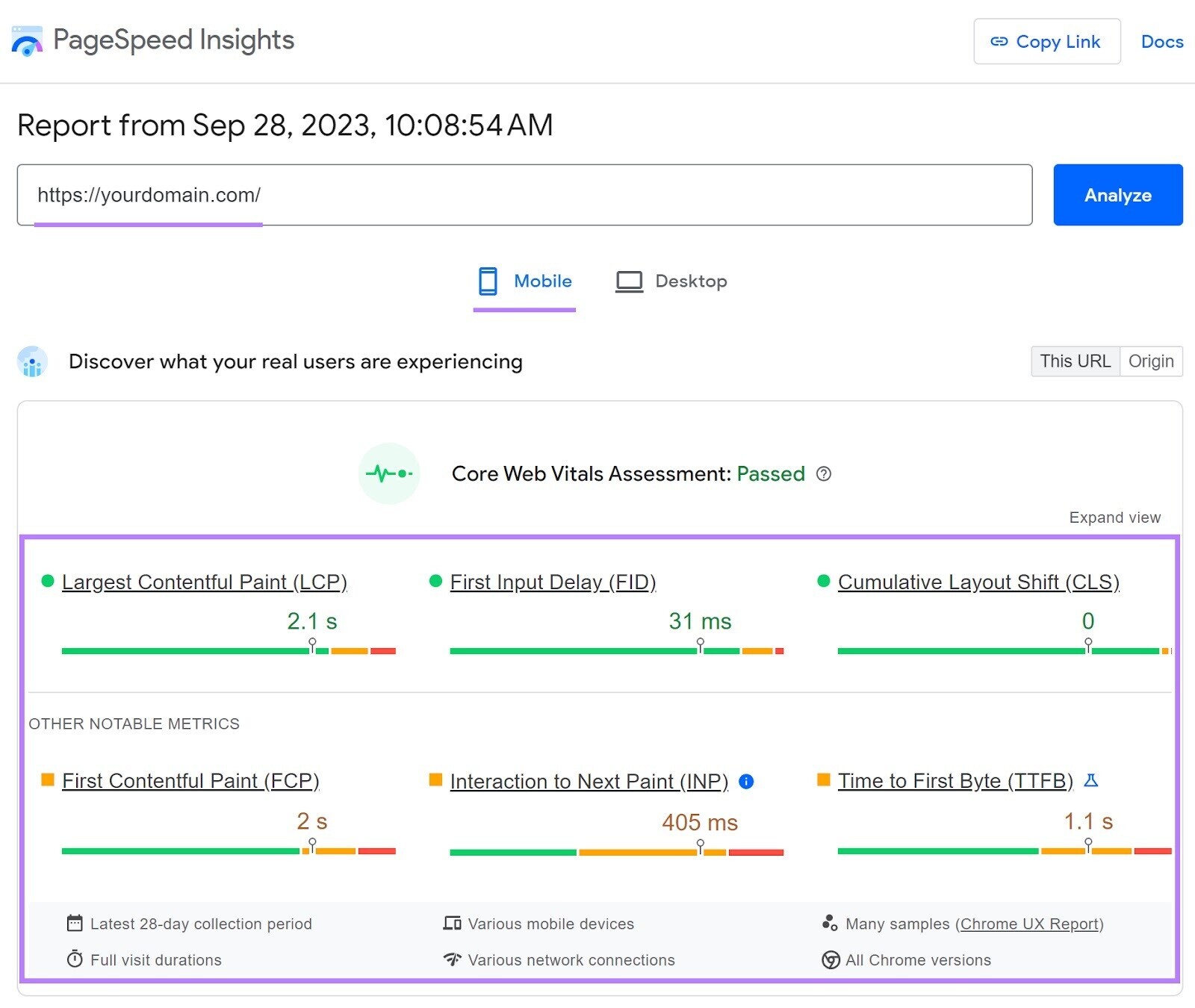
PageSpeed Insights assesses the performance of a webpage for both desktop and mobile devices. It provides a score indicating performance, with suggestions on how to improve page speed.
Using PageSpeed insights, you can understand the following metrics:
- First Contentful Paint (FCP)
- Speed Index (SI)
- Largest Contentful Paint (LCP)
- Time to Interactive (TTI)
- Total Blocking Time (TBT)
- Cumulative Layout Shift (CLS)
The tool suggests ways to improve site performance, such as eliminating render-blocking resources, minimizing HTML and CSS file sizes, optimizing images, and more.
PageSpeed Insights provides an API to pull the data into many other tools, including Looker Studio.
5. JetOctopus
JetOctopus is a scalable audit tool used primarily for large websites. Rather than crawl limits, they offer unit pricing based on the size of your website (number of pages).

In addition to traditional website audits, they also offer website log analysis to help uncover strange patterns or potential issues with your site’s crawlability or indexability.
It features:
- SEO Crawler: Detects technical issues that might hurt SEO performance, such as broken links, server errors, duplicate content, and more
- Log Analyzer: Looks through your website’s log files to understand how search engine bots (and other bots) interact with your website
- GSC Insights: Analyzes GSC data to identify insights, trends, and issues you can address
6. Screaming Frog SEO Spider
One of the classic tools used by technical SEO experts, Screaming Frog provides a comprehensive (albeit complex) set of tools to crawl and audit your website.
The Screaming Frog SEO Spider audit tool can identify issues like:
- Broken links
- Redirect chains and loops
- Problematic robot.txt directives and crawl settings
This tool provides a detailed analysis of the technical health of your site and opportunities for on-page optimization.
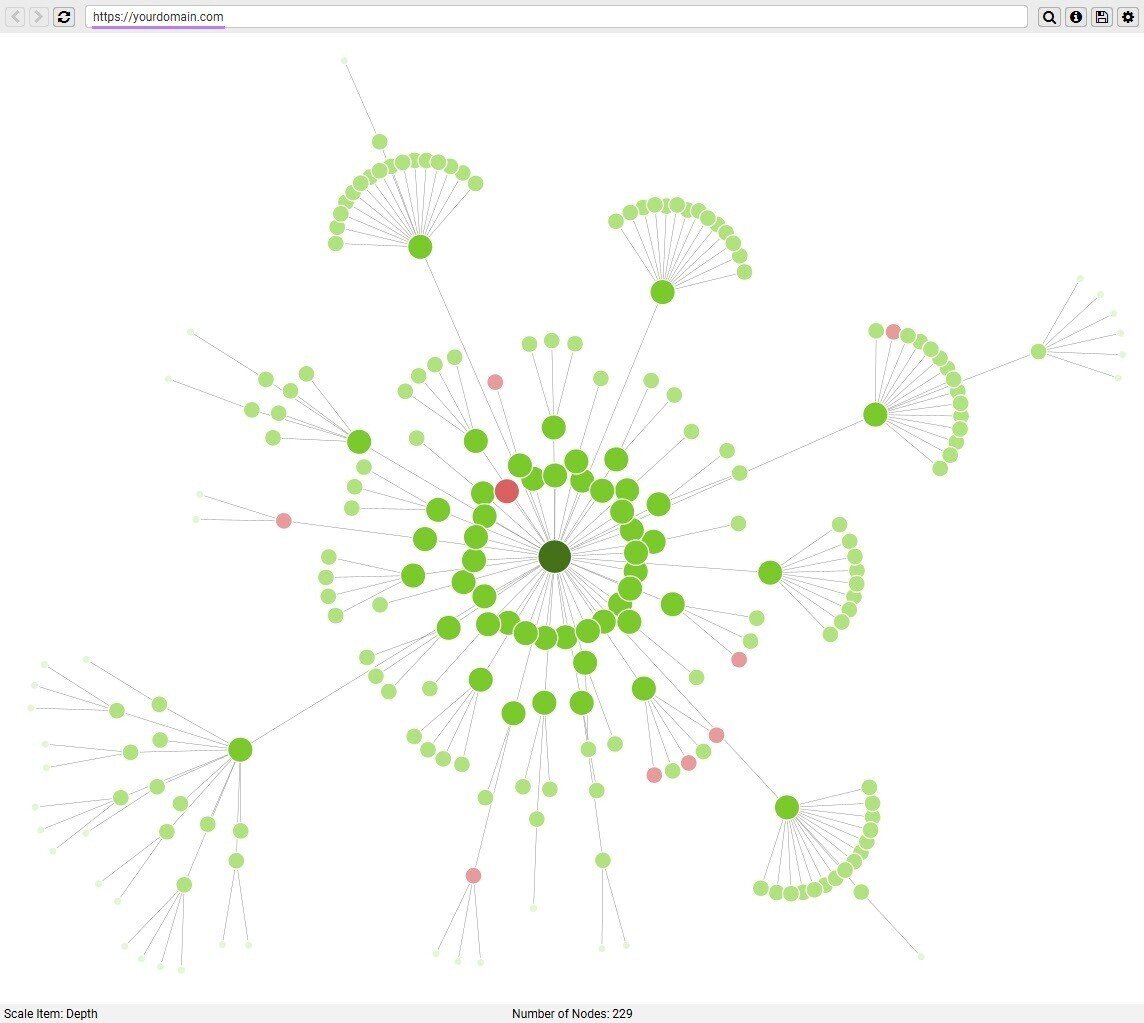
Spider SEO also generates a visual sitemap of your pages and integrates with Google Analytics, GSC, and PageSpeed Insights. You can audit up to 500 URLs for free with this tool.
7. Ahrefs Site Audit
Ahrefs offers a suite of SEO reports, keyword research tools, and a backlink checker. Their site audit tool provides insights you can use to identify and fix SEO issues that could be affecting users and causing a drop in rankings.
Use their audit tool to look for common SEO issues like broken links, empty H1 tags, missing meta descriptions, and slow pages. Ahrefs categorizes issues as “Errors,” “Warnings,” and “Notices.”
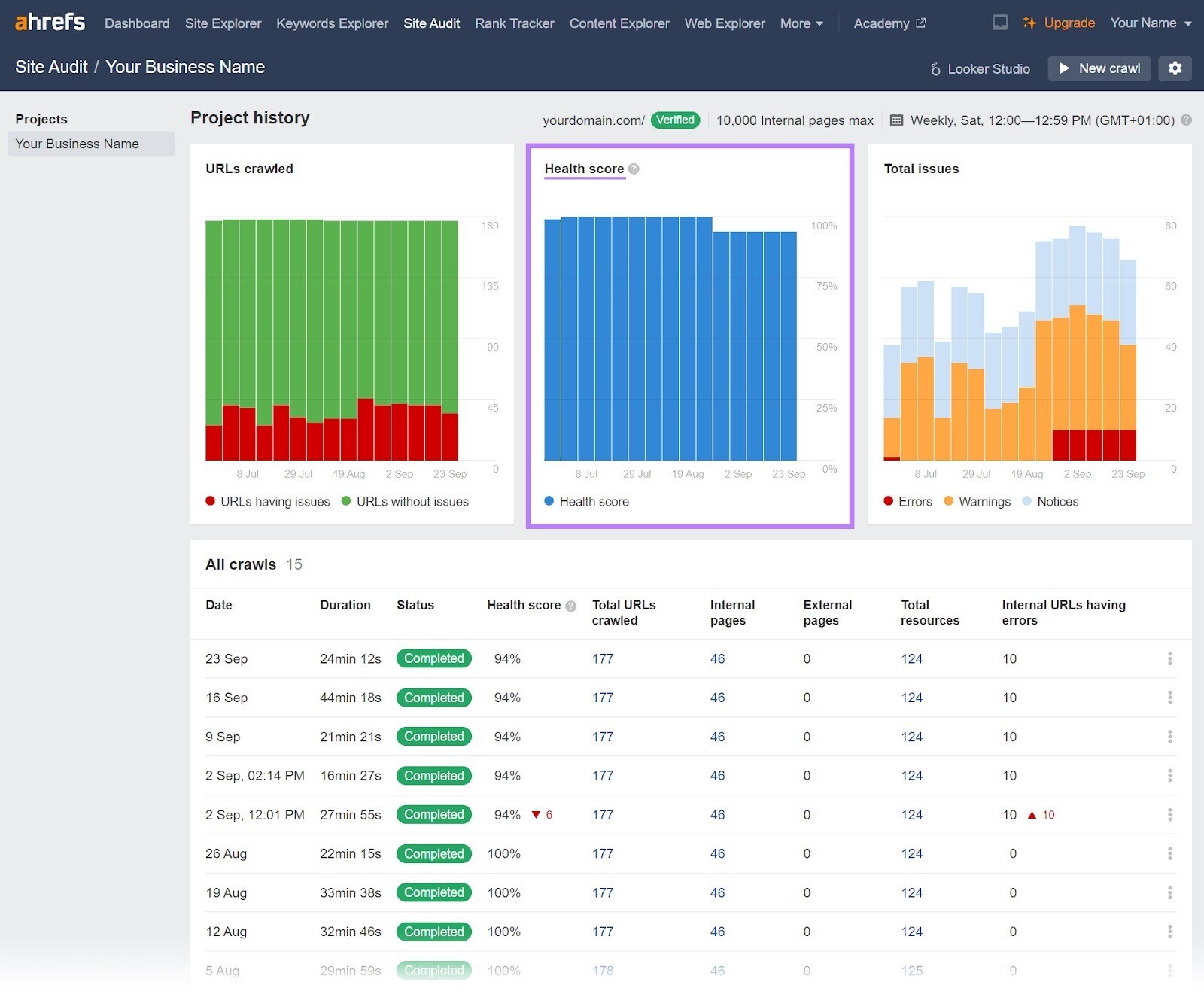
Ahrefs’ tool also provides an overall “Health Score” based on the number and severity of SEO issues discovered in the audit. Integrations include DataBox, Supermetrics, and Whatagraph.
You can schedule regular crawls to run automatically. This tool is free for up to 5,000 pages.
8. Moz Site Crawl
Moz is known for offering a suite of digital marketing tools, including Site Crawl.
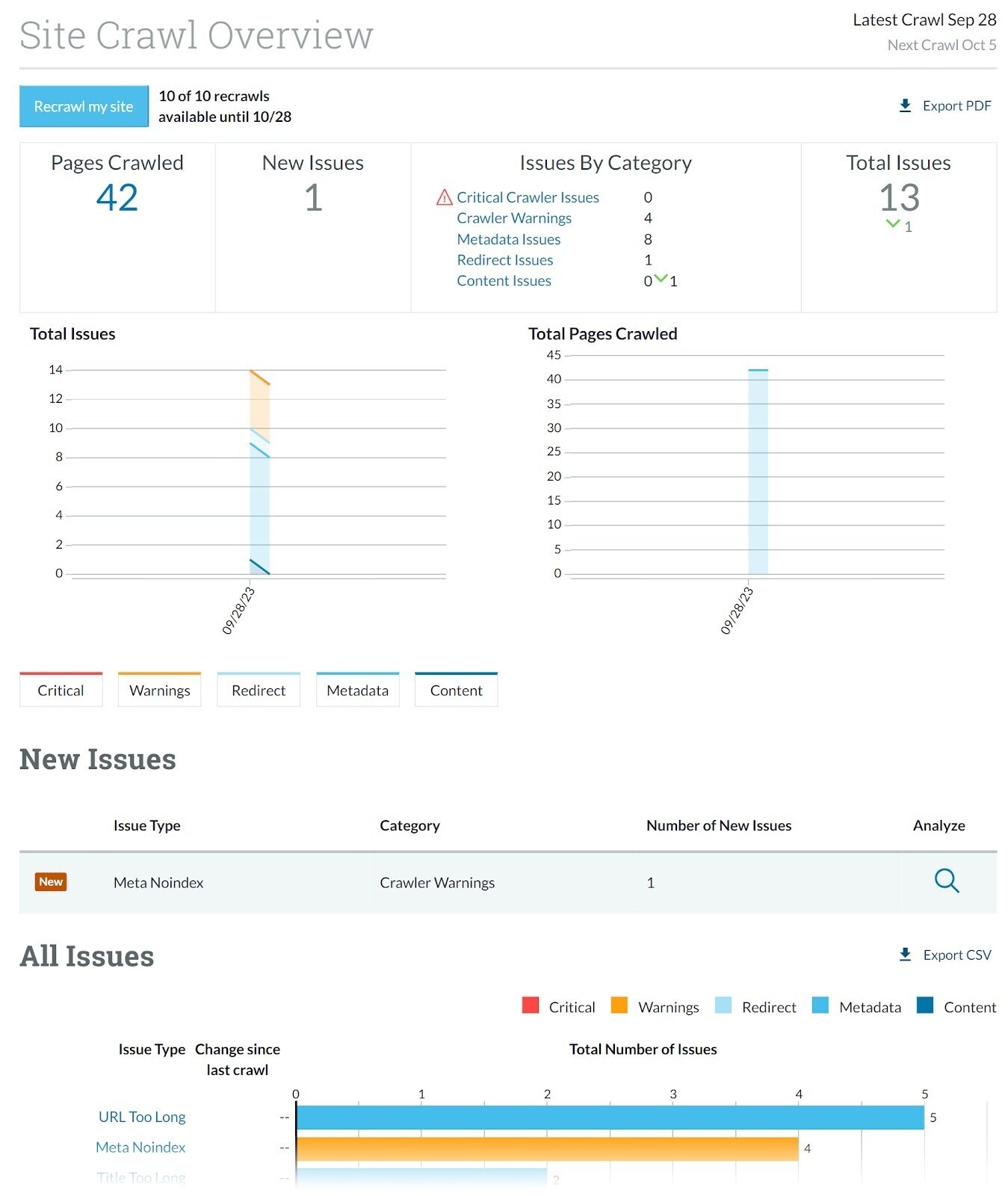
This site audit tool can crawl and monitor your website for common SEO problems like missing title tags, broken redirects, and long meta descriptions. It includes a breakdown of each issue and how to fix it.
The tool also provides prioritization levels for which issues to fix based on potential impact. It groups issues into low, medium, and high priority, so you know which ones could affect your site the most.
Moz offers an API and a range of third-party extensions. Popular options include HubSpot Marketing Grader, Linkody, and WordPress.
Moz Site Crawl is included with a paid subscription, which starts at $99 per month.
9. SE Ranking Website Audit
SE Ranking provides tools for website audits, rank tracking, and competitor analysis. They also offer white-label options available for agencies and consultants.
Their Website Audit tool can crawl up to 1,000 pages on your website in two minutes.
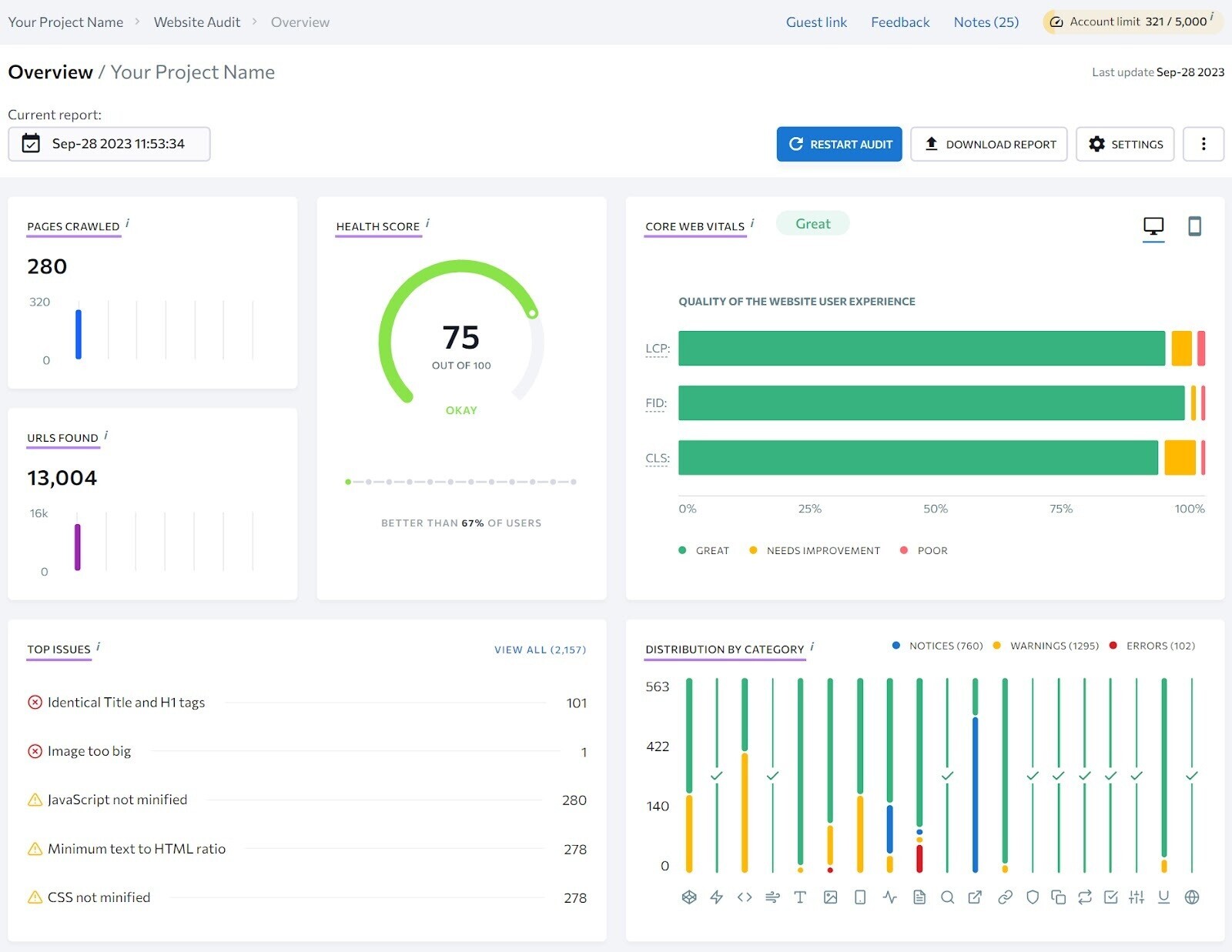
The provided report includes:
- Number of pages crawled
- URLs found
- Top issues
- Distribution by category
- Health score
- Core Web Vitals
The tool can also monitor specific pages that you choose and alert you to any changes. Pricing for SE Ranking starts at $55 per month.
10. SEO Site Checkup
Billed as a tool for “webmasters, small business owners, and SEO agencies,” SEO Site Checkup offers features like:
- SEO analysis
- Uptime monitoring
- Broken link detection
SEO Site Checkup audits your site for over 70 SEO factors that could impact your rankings, from loading speed to keyword position tracking.
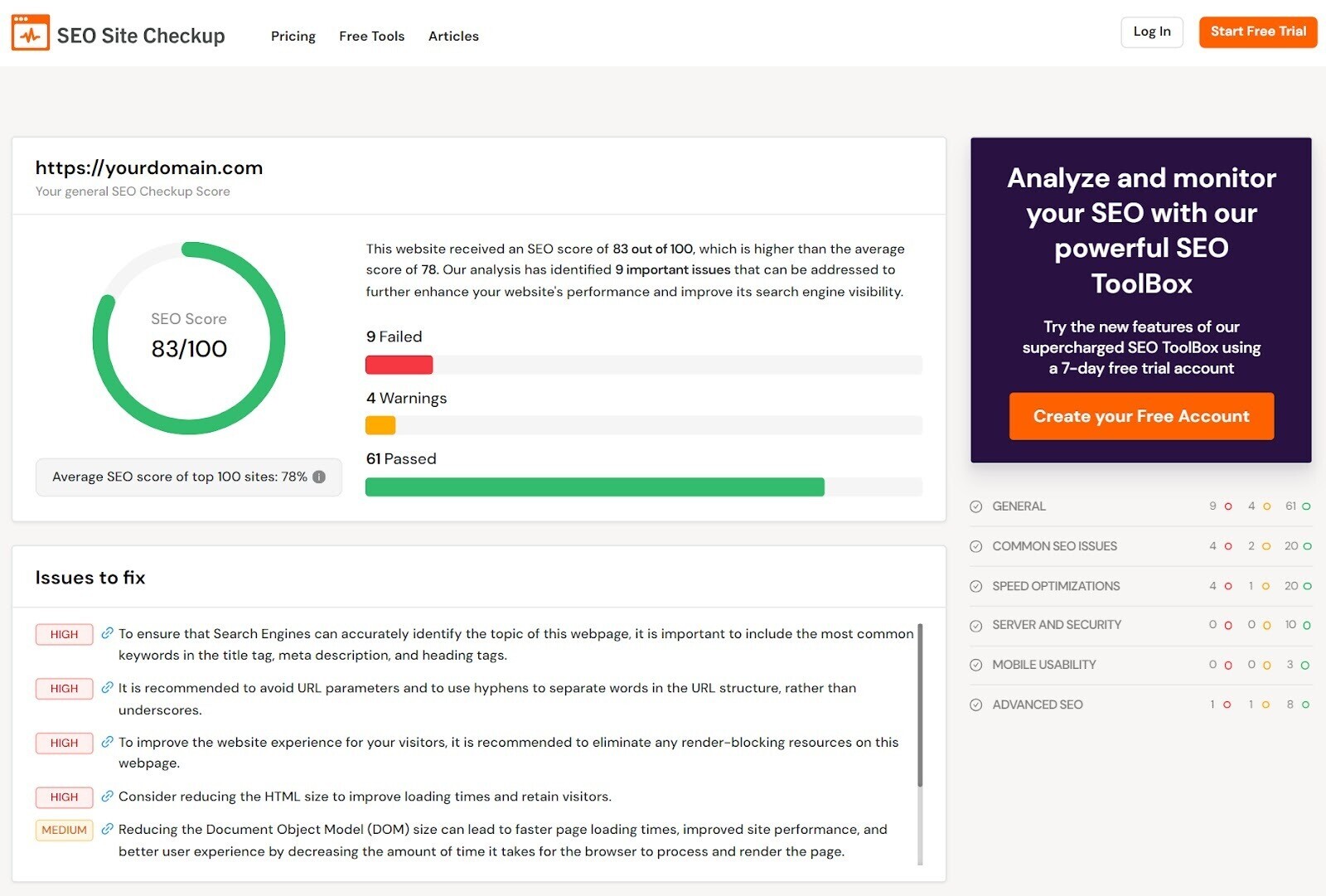
You can also create automated checkups that regularly crawl your website for new issues or changes.
Pricing for this tool starts at $29.95 per month.
Audit tools make it fast and easy for you to check your site’s health on a regular basis. Here’s a look at their biggest benefits.
Better Rankings and Traffic
SEO audit tools help you identify and fix issues on your website that may impact SEO.
For example, they can help uncover issues like broken links to pages that no longer exist, missing H1 or title tags, and orphan pages that may not be crawlable by search engines.
Any of these issues could cause your website to miss out on organic traffic—which means missing out on potential leads, customers, and revenue.
But SEO audit tools help you uncover these issues, understand how they impact your site, and teach you how to fix them.
Audit tools also improve user experience by alerting you to slow pages, clickable elements that are too close together, and much more.
Easy-to-Implement Solutions
SEO issues can be complex, but audit tools help simplify them for users.
They help you track and fix a wide range of issues that could otherwise be difficult to understand or measure on your own.
Many of these tools look at a variety of ranking factors and best practices, including:
- On-page SEO: How the page’s code is structured, meta information, and the page content
- Off-page SEO: Number, quality, and quantity of backlinks
- Technical SEO: Your site’s overall crawlability and indexability
- User experience: How easy it is for the user to browse or use the website
- Site performance: Site load speed or load times, responsiveness, and other technical performance measurements
- Mobile optimization: How easy the site is to use and navigate from a mobile device (phone, tablet, etc.)
Real-Time Monitoring
Audit tools provide real-time alerts to inform you if a website change creates an SEO issue you should fix.
Without regular audits, these problems could go unnoticed indefinitely, which could harm your rankings or create even worse issues over time.
But with audit tools, you’ll get notifications when these issues pop up, ensuring you can take action as soon as possible.
Actionable Tasks
SEO audit tools help you understand which SEO issues are urgent and which ones can wait.
In each report, you’ll get an explanation of why the task is urgent and information on how to fix it. You can work through the tasks, starting with the ones that could have the greatest impact on your site, until you’ve addressed all errors.
Fixing these errors is an easy way to improve or maintain rankings and boost your site’s visibility in search engines.
If you’re considering using an audit tool, you’ll want to ensure it has the following features:
On-Page Website Analysis
A great audit tool should analyze on-page SEO factors:
- Meta tags and metadata: Titles and descriptions
- Internal links: Broken links and quantity of links
- External links: Broken links and quantity and quality of links
- Headings: H1, H2, etc.
- Structured data and markup: Proper use of Schema and Open Graph data
- Content quality: Thin pages or missing content
Technical SEO Analysis
You’ll want an audit tool that can perform deep technical SEO analysis, checking things like:
- Canonical URLs: Duplicate content and pages on your website
- Redirects (and chains or loops): Directives that send users and bots to pages other than the URL they’re visiting
- Indexing status: Which pages are visible and indexed by search engines
- Sitemap health: The crawlability and accuracy of your sitemap files
- Robots.txt: Instructions for search engines on how to crawl and index your website
- Site structure: The size and shape of the pages on your site
Site Performance Analysis
Additionally, your site’s speed and performance (e.g., page load speed) also affect SEO.
Ideally, your SEO audit tool will benchmark your site on performance metrics that correlate with Google’s Core Web Vitals (CWV).
For example:
- Largest Contentful Paint (LCP): The time it takes to render the largest block of content on the page
- Total Blocking Time (TBT): How long it takes for the page to become responsive to user input
- Cumulative Layout Shift (CLS): The physical distance the page’s content shifts in the browser while loading
Prioritization
Lastly, a critical feature of an effective website audit tool is prioritization.
The tool should help you understand the severity and impact of the issues it uncovers so you can work strategically to resolve the most important problems.

It’s easy to become overwhelmed with hundreds or thousands of issues your site may face. Having a clear understanding of which ones to tackle first makes handling SEO issues much more manageable.
SEO Audit Best Practices
Before you get started, you should know a few best practices for running SEO audits.
Perform Audits Regularly
Depending on how frequently you update your website and publish content, once per month or quarter is a good benchmark.
SEO is a continuous process and regular auditing helps you identify new issues and fix them in a timely manner.
Understand the Metrics
Some of the metrics shown in an audit report are unique or proprietary to the tool you’re using.
For example, the Semrush Site Audit tool provides an overall “Site Health” score derived from the number of Errors and Warnings detected in the latest audit.
Taking the time to understand each report’s metrics will help you make critical decisions about your site’s SEO.
Take Advantage of Integrations
Integrations can make your audit more comprehensive by providing helpful data from third-party tools.
Many SEO tools, including Semrush’s Site Audit and On Page SEO Checker, offer integrations with other platforms such as Google Analytics, Google Search Console, and Looker Studio.
Source link : Semrush.com
